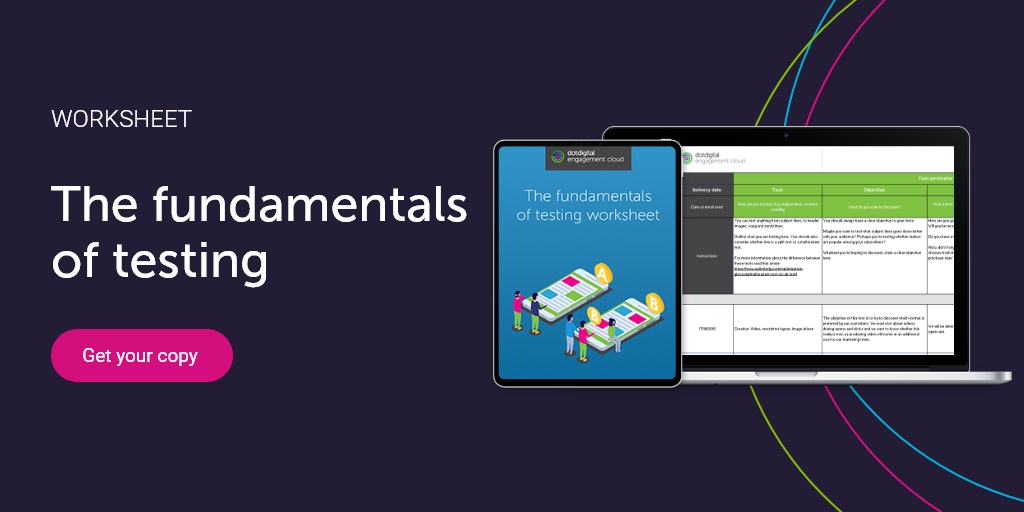Why split-testing isn’t just splitting hairs


Split-testing isn’t a new marketing tactic. In fact, it’s nearly as old as email marketing itself. And yet, many marketers still don’t take the time to test and optimize their email marketing campaigns.
Why is split-testing important?
Split-testing allows you to compare and contrast the impact of various elements of your email marketing campaign. By measuring your subscribers’ reactions to these changes, you can optimize your campaigns to get the results you want.
Testing allows you understand which tactics get the best results, while helping you keep your marketing fresh.
Depending on what you’re looking to improve, there are endless opportunities for you to discover what drives your subscribers into action.
What email marketing elements can you split-test?
While there are endless variations of tests you can perform on your email marketing, there are five core elements you should be regularly testing to ensure you’re getting the best results possible.
1. Subject lines
Definitely the most common element tested by email marketers, subject lines are the first thing a reader sees when your email lands in the inbox. You should be regularly testing this part of your marketing to avoid stagnation. You don’t want readers to get so used to your subject lines that they stop engaging them and driving them into action.
Ways you can test subject lines include:
- Length: testing short vs. long subject lines.
- Personalization: using first name, last name, or even location.
- Emojis: do your audience engage more with emojis or less?
- Promotions or offers: leading with “free shipping” or “Open for 20% off everything”
2. Pre-header text
The pre-header text is one of the most underutilized elements of email marketing. As the first line in your email marketing campaign, pre-header text works in partnership with your subject line to drive subscribers to open your email.
By utilizing pre-header text, you can give readers a “sneak peek” at the in-email content, or personalize it to complement the offers in your campaign. By split-testing these tactics, you can see whether your pre-headers have an impact on a reader’s decision to open your email.
3. Send time
Landing in the reader’s inbox at the right time determines whether or not your email gets opened. If you always send your email newsletter at 12pm on Friday afternoons, you’re likely to be contending with a large number of other brands.
Varying when and on what day your audience receives your marketing prevents your marketing from becoming stagnant and also gives you a clearer insight into your audience. Maybe your target audience is more receptive to emails waiting for them as they commute to work or back home at the end of the day. The only way you’ll know is to test.
4. Call-to-action
Getting your call-to-action (CTA) right in your campaign is essential to getting the results that drive revenue and growth.
In your email marketing campaigns, you need your CTAs to stand out. Thanks to split-testing, you can test the size, color, and text of your CTA buttons. Doing this will help you discover the style and copy that drives readers to convert. If you’re looking to improve your click-through rate (CTR) this is an essential element to be testing.
5. Content
The content in your email can be changed in so many ways, so understanding what works with your audience is an insight you can’t underestimate.
To unlock this information, you should be testing your content regularly:
- Length: how much are readers willing to scroll or reader?
- Images: do readers prefer a visual email or are they looking for copy and insight?
- Language: are readers more receptive to positive or negative language?
- Personalization: does using a name or location-based personalization improve your readers’ response to your marketing?

How to successfully split-test your email campaigns
Every email marketer knows that split-testing isn’t just splitting hairs. It’s not done just to check a box. It serves a powerful purpose that can improve your marketing results ten-fold. But for you to reap the rewards, you need to ensure your tests are set-up for success
1. Set measurable objectives
What are you trying to improve? Before you set-up your test, you need to decide how you’re going to measure your success. This may include:
- Open rates
- Click-through rates
- Click-to-open rates
- Revenue
- Conversions
2. Choose what to test
Depending on what results you what to see, you may decide to test very specific elements. If you’re looking at open rates, subject lines and pre-header text are the obvious elements to choose from. Testing CTAs will help you improve your CTR, while testing the content and send time may deliver the results that help you improve your revenue.
3. Consider your sample size
You need to pick a realistic sample size to get meaningful results. Too small and you won’t learn a great deal, but too large might take too long to get your results.
For small audiences, you can test on larger sample size, such as 10% or 20% of your mailing list. If you have a larger database, testing on the same amount of people will require a sample size of about 5%.
4. Optimization
Once you’ve discovered what tactics are most popular with your audience, it’s time to implement them. What has your test uncovered? Do your audience prefer visual, image-based emails or insightful, copy-based content. Are they more engaged with subject lines that contain emojis than personalization? Whatever insights your test has uncovered, it’s time to optimize your strategy to drive your results.
5. Test, test, and test again
The only way to ensure your marketing continues to land with impact in your subscriber’s inbox is by frequent testing.
Just because changing the time of day your email arrives works after initial testing, doesn’t mean it always will. If you don’t change your tactics, your results will stall as readers become bored of receiving that same thing, time and again. The only way to surprise and delight your customers is to keep your material fresh. Continuous testing will help you achieve this.
The fundamentals of testing
Testing and tracking don’t have to be hard. We’ve got an easy-to-use worksheet to help your compare and contrast your testing results. You’ll be able to easily identify which strategies work for your marketing database and spot trends in your audiences so you can continually improve your marketing. Download the fundamentals of testing today.



